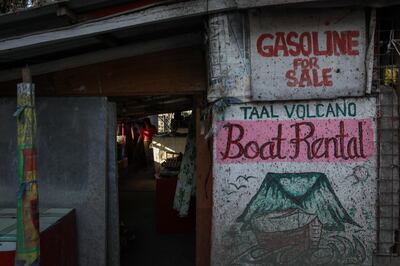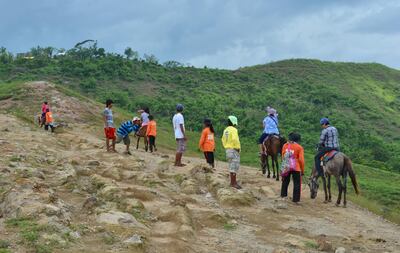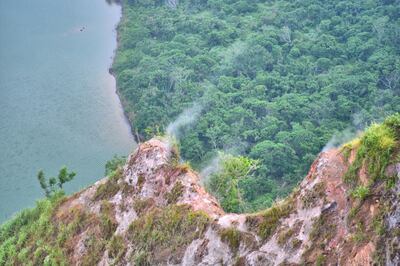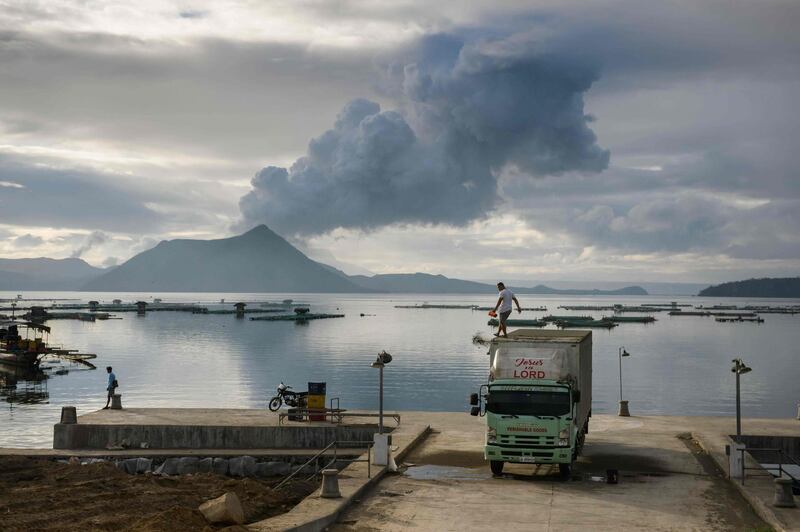It became one of the Philippines' top tourist attractions due to its gorgeous setting and notoriety as the world's smallest active volcano. Now, as ash spews from Taal volcano for the 10th consecutive day, this eruption is threatening lives, livelihoods and the future of the tourism industry in Tagaytay, 60 kilometres south of the Filipino capital, Manila.
Taal began erupting on January 12, affecting almost 500,000 people who live inside the 14km-radius danger zone. While there are not yet believed to have been any deaths directly caused by the eruption, seismologists have warned there is an imminent risk of a much larger and potentially deadly explosion. As a result, Philippines authorities have put in place a level four alert, the second-highest rating for a volcano.
Police have set up roadblocks on the perimeter of the danger zone, preventing vehicles from entering, while attempting to evacuate buildings housing residents within the hazardous area. The volcano is on an island within a lake, which is itself inside an island, all of which is part of a huge volcanic crater called the Taal caldera. At 311 metres tall, it is reputedly the world's smallest active volcano, and has erupted more than 30 times in the past 400 years, causing thousands of deaths.
But the volcano's last eruption was 43 years ago and, in the meantime, it has helped build a strong tourism industry in Tagaytay, the small city on the northern edge of Taal Lake, as well as on the volcanic island itself. An 80-minute drive from downtown Manila, a city of more than 13 million people, Tagaytay attracts a huge number of foreign and domestic tourists each year. Some Manila residents escape to this hilltop city to enjoy the fresher air, cooler climate and greater sense of space.
Many more tourists go to the city specifically to visit the Taal volcano. When I visited Tagaytay three years ago, the moment my bus from Manila stopped in the city, touts crowded around the alighting passengers, offering us volcano tours. Some of these packages were upmarket, involving chauffeured cars to Taal lake, private boats across to Volcano Island, catered food and organised activities on the island.

Most of them, like the one I chose, were no-frills. An autorickshaw drove me to the lake, where I walked down a rickety wooden jetty and joined other tourists in a small pump boat, a motorised version of the traditional Filipino outrigger vessel. During our 20-minute ride to the island, I chatted with the other passengers, all of whom were Filipinos on day trips from Manila. When I asked them if they thought visiting the volcano was safe, they shrugged. One man answered that it must not be dangerous given how many other tourists were flocking to the island.
At the island’s main pier, we were greeted by tour guides promoting their services, touts advertising horse rides to the rim of the volcano and locals offering homestay accommodation on the island. This latter group caught me by surprise. I had been unaware that, despite this island being home to a deadly volcano, it was also inhabited by more than 5,000 people, who live in several scattered villages.
The island's appeal to its residents is obvious. It is quiet and unspoilt, has rich volcanic soil perfect for farming, and boasts beguiling beauty thanks to its lush, green environment, the pristine waters of the lake, and the dramatic presence of the Taal volcano. All of this, combined with the 43-year lull in the volcano's activity, was enough to convince the villagers that the island was a fine home. Not to mention the employment opportunities associated with volcano tourism in a region plagued with widespread poverty.

During my day at the volcano, I met dozens of people directly employed in this industry. They include boat captains, guides, touts, birdwatching teachers and the staff that manned the tourism offices, snack stalls and restaurants near the main pier and at the volcano rim. For $20 (Dh73.5), tourists could hire a horse and a handler to head from the pier up to the rim. I hiked instead and, after a 40-minute ascent, arrived at the rim to be met by smiling ice cream sellers, photographers glad to take images for a fee, and people renting golf clubs with which to hit balls down into the crater.
As I watched Filipino men laughing while they tested their golf skills, children giggling between licks of their ice creams, and hugging couples posing for photos, I saw something that ruptured this atmosphere of frivolity. On the steep slope from the rim down into the crater, gases were rising out of the ground. This was a bracing reminder of the instability and hazardous nature of my environment.

That sight, combined with the strong chemical odour in the air, snapped me out of my relaxed, complacent state of mind. Later, as I made the return boat ride to Tagaytay, I looked back at the volcano and wondered how long it would be until it erupted again.
Now, the entire island is cloaked in thick layers of ash, which have destroyed crops not just there but also in many villages that surround the lake. Even if a larger eruption does not occur in the coming days or weeks, what has taken place here already has left hundreds of thousands of lives in limbo. It still remains unclear when residents of the danger zone will be able to safely return to their homes, but what is clear, is that it will be a long time before tourism returns to Taal volcano.











